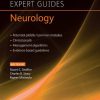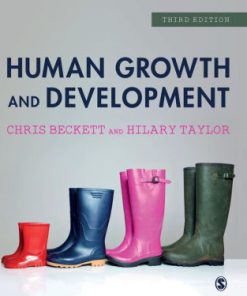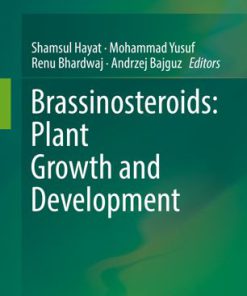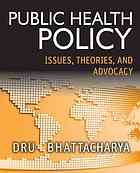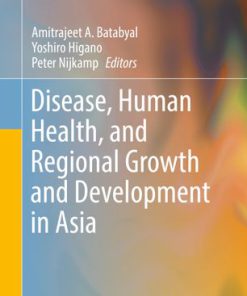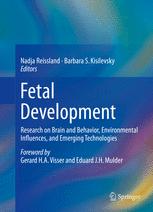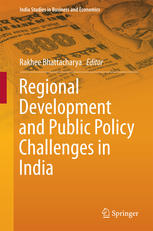Human Fetal Growth and Development First and Second Trimesters 1st Edition by Niranjan Bhattacharya 3319148748 9783319148748
$50.00 Original price was: $50.00.$25.00Current price is: $25.00.
Human Fetal Growth and Development First and Second Trimesters 1st Edition by Niranjan Bhattacharya – Ebook PDF Instant Download/DeliveryISBN: 3319148748, 9783319148748
Full download Human Fetal Growth and Development First and Second Trimesters 1st Edition after payment.
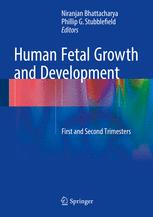
Product details:
ISBN-10 : 3319148748
ISBN-13 : 9783319148748
Author: Niranjan Bhattacharya
This unique book delves into the mysteries of human fetal growth and maturation. Growing knowledge in genetics indicates that factors that impact on/influence fetal growth and maturation may have a role in determining a person’s health and disease in later years. Placental, maternal, environmental, nutrient as well as fetal genome factors each play a role in producing a healthy, unhealthy or abnormal baby. A study of fetal growth and maturation is therefore basic to the understanding of why fetal growth problems occur, what implications these can have for adult disease, and how clinical intervention can help to reverse growth problems. The present study will be comprehensive and will be a major contribution to the fields of gynecology, genetics, obstetrics, biochemistry, molecular biology and clinical medicine. It will include cutting edge research in the field as well as explorations on clinical interventions in fetal growth, which will not only add to existing knowledge but also prompt future research. The two Editors are distinguished in their fields and both have extensive clinical and research experience. They felt that they could use their expertise to create a book that will help students, practitioners, researchers and others to understand the subject of gestation, growth and maturation and its implications from a multi-dimensional point of view, which will help them develop their own expertise in a cutting-edge and developing field. They have brought toget her medical scientists, clinical practitioners, embryologists, endocrinologists, immunologists, gynecologists, obstetricians, reproductive and molecular biologists, geneticists and many others to create a state-of-the-art book on a subject with increasing demand for further knowledge. It aims to integrates different disciplines to give a holistic view of human fetal growth maturation.
Human Fetal Growth and Development First and Second Trimesters 1st table of contents:
Part I: Introduction
1: Fetal Growth
Introduction
Physical Growth and Its Measurements
Weight
Length
Head Circumference
Nucleic Acids
Proteins
Specific Protein Synthesis
Conclusion
References
2: Vaccination of the Unborn: A Perspective
Introduction
Theoretical Prospect/Potentialities of Vaccinating the Unborn
Advantages and Disadvantages of Immunization
Role of Antigenic Stimulation on Fetal Intra Uterine Growth: Implications of Increase in Liver Weig
Theoretical Problem of Graft versus Host Reaction and Autoimmunity in the Aborted and Non Abor
Advantage of Hypoimmune Fetal System in Biomedical Research
References
3: Understanding the Growth of the Fetus in Utero from the Immunologists’ Angle
Development and Growth of the Human Immune System in Utero
Natural Immunity (Cellular Component of Macrophage Monocyte Natural Killer Cell System)
Natural Immunity (Humoral Component)
Other Humoral Factors of Natural Immunity
Acquired Immunity-Cell Mediated and Antibody Mediated Responses of T Lymphocytes
Lymphokines Production and Role in Cell Mediated Immunity
Antibody Production in the Fetus and Neonates
Placental Transfer of Antibody
References
4: Intraamniotic Antigen and Disruption of Human Fetal Growth: A Study from 1978–2002 with Su
Intra Amniotic Antigens as Abortifaecients
Post Abortion Maternal Effect
Future Pregnancy Potential
What Is Our Ultimate Learning from This Search for a Safe, Effective, Cheap Midtrimester Abortif
Reaction of the Pre-immune or Hypo-immune Fetus (up to 20 weeks)
Implications of This Type of Research in the Field of Fetal Surgery and in Understanding the
Future of Hematopoietic Stem Cell Transplant in Utero
Conclusion
References
5: Fetal Growth and Development in the First Two Trimesters
First Two Trimesters
Perspectives on Fetal Growth and Development across Culture and Time
The Anatomical and Physiological Perspective of Fetal Development in the First Two Trimesters
Nine to Twelve Weeks
Thirteen to Sixteen Weeks
Seventeen to Twenty Four Weeks
Systemic Development
Respiratory System
Cardio-Vascular System
Gastrointestinal System
Urinary System
Central Nervous System (CNS)
Genetic and Epigenetic Perspectives of Fetal Development
Factors Influencing Fetal Growth and Development
Fetal Parameters
Maternal Parameters
Microchimerism
Cytokine Response to Prenatal Infections during Fetal Development
Fetal Allograft
Diagnostic Parameters
Ultrasonography
Diagnostic Amniocentesis
Alpha Feto Protein Assay
Characterization of First Trimester Fetal Erythroblasts for Non‐invasive Prenatal Diagnosis
Spectrophotometric Studies
Chorionic Villus Sampling
Conclusion
References
Part II: Structural and Functional Fetal Development up to Second Trimester
6: Anthropometric Measurement of the Human Fetus
Anthropometric Measurement of Human Fetuses
Anthropometry of Individual Organs
Growth of the Liver
Growth of the Lung
Growth of the Brain
Growth of the Kidney and the Adrenal Gland
Growth of the Human Fetal Testes
Growth of the Human Fetal Ovaries
The Growth in Mass of the Thymus
References
7: Human Fetus: Carbohydrate Metabolism
Introduction
Blood Sugar Concentration in Fetal and Maternal Blood
Glycogen Content in the Human Fetal Liver
Inorganic Phosphorus Content in the Human Fetal Liver
Phosphorylase Activity in the Human Fetal Liver
Glucose: 6 Phosphatase Activity of the Human Fetal Liver
Fructose 1,6: Diphosphatase in Human Fetal Liver
Discussion
Summary and Conclusion
References
8: Mucopolysaccharides, Water and Electrolytes of Human Fetal Organs
Introduction
Structure of Mucopolysaccharide
Matrix
Function of Mucopolysaccharide
Electrolytes Control in the Connective Tissue
Methods of Investigation
Fractionation of AMPS
Glucosamine-6-p Synthetase (E.C. 2.6.1.16)
Result
Liver
AMPS Concentration in Human Fetal Liver Tissues
Water and Electrolyte Content of Human Fetal Liver (Including Different Compartments of the Tis
Correlation of Water, Electrolytes and AMPS Concentration
Lung
Total AMPS of Lung and Its Fractionations
Different Fractions of Total AMPS of Human Fetal Lung and Its Composition
Water and Electrolyte Contents of Lung
Brain
Mucopolysaccharides of the Human Fetal Brain at Different Gestation Periods
Sodium and Potassium Concentrations in the Human Fetal Brain
Glucosamine-6-Phosphate Synthetase (EC 2.6.1.16) in Liver, Brain and Lung
Discussion
MPS and Relationship with Water and Electrolytes
Liver
Mucopolysaccharide
Water and Electrolytes
Lung
Mucopolysaccharide
Water and Electrolytes
Brain
Mucopolysaccharide
Water and Electrolytes
Glucosamine-6-Phosphate Synthetase
Conclusions
Summary
References
9: Urea Biosynthesis in the Human Fetal Liver
Introduction
Biosynthesis of Urea in Mammals during Development
Ammonia Nitrogen and Urea Nitrogen Concentrations of the Bladder Fluid and Plasma
Enzyme Activity
Ornithine Transcarbamylase during Development
Activities of Argininosuccinic Acid Synthetase during Development
Activities of Argininosuccinase during Development
Activities of Arginase in Developing Human Fetuses
The Probable Rate in Which Urea Can Be Produced
Concentration of Ornithine in Human Fetal Liver
Concentration of Polyamines in Human Fetal Liver
Activities of Ornithine Amino Transferse (EC.2.6.1.13) during Development of Human Fetuses
Discussion
Summary
References
10: Mechanism of Rejection of Human Fetal Adrenal Cortex
Introduction
Histological Study
At About 8 Weeks of Gestation
At About 9 Weeks of Gestation
At About 12 Weeks of Gestation
At About 13 Weeks of Gestation
At About 17 Weeks of Gestation
At About 19 Weeks of Gestation
At About 24 Weeks of Gestation
At About 28 Weeks of Gestation
At About 32 Weeks of Gestation
At About 2 Days of Age
At About 7 Days of Age
Fractionation of Soluble Proteins in the Adrenal Glands of Fetuses
Fetal Specific Adrenal Protein
Production of Rabbit Antibodies against Human Fetal and Adult Adrenal Cortical Extracts
Rabbit Antibodies to Fetal Adrenal Cortex (Phosphate Buffered Saline)
Antibodies to Fetal 1M Extract of Adrenals
Antibodies to PBS Extracts of Adult Adrenal Glands
Antibodies to 1M NaCl Extracts of Adult Adrenal Glands
Antibodies to PBS Extracts of Fetal Adrenal Glands
Antibodies To PBS Extract of Adult Adrenal Gland
Antibodies to One M Nacl Extracts of Adult Adrenal Glands
Characterization of Fetal 1M Antigens
Presence of Autoantibodies in Postnatal Life against Fetal Adrenal Antigens
Ouchterlony System
Quantitative Immunoprecipitation Test
Passive Hemagglutination Test
Passive Cutaneous Anaphyl Axis Test
Migration Inhibition Factor of Sensitized Lymphocytes and Macrophages
Conclusion
Summary
References
11: Development of the Human Fetal Brain
Introduction
Proliferation
Migration
Differentiation
Growth in Numbers
Anthropometric Measurement of the Human Fetal Brain
Biochemical Changes in the Human Fetal Brain
DNA and RNA Content
Protein Content
P32 Incorporation in DNA, RNA and Phospholipid
Synthesis in the Human
Histological Studies of the Human Fetal Central Nervous System
Discussion
Anthropometric Measurement
Nucleic Acid Contents
Enzymes: Glutamine Synthetase
In Vitro 32P: Incorporation
In Vitro 14C-Leucine Incorporation
Incorporation of U 14C- Glucose In Vitro
Histological Studies of the Human Fetal Central Nervous System
Development of the Eye
Development of the Somites
Cortical Histogenesis
Development of the Midbrain
Development of the Cerebellum
Summary and Conclusions
References
12: Lipid Metabolism in the Human Fetus Development
Introduction
Lipids Synthesis and Transport
Fetal Cholesterol
CHO Transport
Fetal Fatty Acids and Triglycerides
Fetal Fatty Acids and Triglycerides Transport
Fetal Lipoproteins and Molecular Mechanisms
Fetal Consequences of Maternal and Fetal Disorders
Maternal Disorders
Familial Hypercholesterolemia
Pre-eclampsia
Diabetes
Fetal Disorders
Intrauterine Growth Restriction (IUGR)
Defects in the Cholesterol Biosynthetic Pathway
Conclusion
References
Part III: Gene and Human Fetal Development up to Second Trimester
13: Gene Regulatory Networks and Epigenetic Modifications in Cell Fate Decisions During the Early
Introduction
Gene Regulatory Networks
Chromatin Modifications and Cell Differentiation
Transcription Factors Involved in Differentiation of the Zygote
Differentiation of Inner Cell Mass into Epiblast and Primitive Endoderm
Discussion and Conclusion
References
14: Personal Human Life Begins with the Formation of Adult Type Hippocampus at 13th Week of Deve
When Does Personal Human Life Begin?
Brain Cortex and Personhood
Hippocampal Development
Hippocampal Birth at 13th Week of Development
Soul Must Have a Material Component
Vomeronasal System as a Point of Entry for the Soul Together with Dark Matter
Conclusion
References
15: Dependence of Fetal Hair and Sebaceous Glands on Fetal Adrenal Cortex and Possible Control f
Introduction
Development of Fetal Adrenal Cortex
Dependence of Fetal Hair and Sebaceous Glands on Adrenal Androgens
Regulation of Adrenal Androgen Secretion
Evidences for a Regulatory Paracrine Effect of Medullary Cells on Cortical Cells
Merkel Cells and Adrenal Medulla Might Play a Role in the Fetal Adrenal Androgen Secretion
Conclusion
References
16: Theoretical Postulation of the Embryological Basis of the Virgin Birth and Role of Embryon
Introduction
A Human May Have Functional Male and Female Gonads
A Left Ovary and a Right Abdominal Testis May Develop in a Human
Transperitoneal Migration of Gamets to Contralateral Oviduct
Pregnancies in Chimera
Self-Fertilization
Scenario for Mary to Give Birth to Jesus without a Father
Embryonic Stem Cells Localized out of the Embryo
References
17: Aneuploidy in Human Preimplantation Embryos
Introduction
Lessons from Cytogenetics
Aneuploidy in Oocytes
Aneuploidy in Spermatozoa
Abnormalities in Preimplantation Embryos
Conclusion
References
18: The Potential Impact of Maternal Milk Consumption During Pregnancy on mTORC1-Driven Fetal Grow
Introduction
mTORC1: The Nutrient-Sensitive Kinase Orchestrating Cell Growth
Insulin/IGF-1 Signaling Activates mTORC1
Amino Acid-Mediated Activation of mTORC1
The Glutaminolysis Pathway Activates mTORC1
Palmitate Activates mTORC1
Glucose Activates mTORC1
Cow’s Milk Consumption Increases mTORC1 Signaling
Milk Induces Hyperinsulinemia
Milk Increases Serum IGF-1 Levels
Milk-Derived Amino Acids Activate mTORC1
Milk-Derived Palmitate Activates mTORC1
Milk-Derived Glucose Activates mTORC1
Milk Consumption in Pregnancy Increases Placental, Fetal and Birth Weight
Milk Consumption Placental Weight Gain and Growth Hormone Signaling
Milk- and Placental Growth Hormone-Induced Insulin Resistance
Milk Consumption and FGF21-Mediated Over-Expression of GLUT1
Potential Role of Milk miR-21 on Fetal Growth
The Role of mTORC1 in Placental Nutrient Transfer
Milk Consumption Increases Maternal Weight
Conclusions and Outlook
References
19: Genetic Disease Specific Human Embryonic Stem Cell Lines
Introduction
Chromosomal Disease Specific Human Embryonic Stem Cell Lines
Genetic Disease Specific Human Embryonic Stem Cell Lines
Conclusion
References
Part IV: Impact of Stem Cell on Growth and Development of Human Fetus
20: Stem Cells in Growth and Development of the Human Fetus
Stem Cells
Early Embryo Development and the Origin of Stem Cells
Roles of Tissue Specific Stem Cells in Morphogenesis: Breast Model
Neural Stem Cells: Generating the Brain
Hematopoietic Stem Cells and Their Roles in Blood Formation
Errors of Stem Cell Self-Renewal, Differentiation and Diseases
Fetal Alcohol Syndrome and Neural Stem Cells
Myelodysplastic Syndrome (MDS): A Stem Cell Disorder
Auto-immune Diseases as Stem Cell Disorders
Conclusions
References
21: The Mystery of the Survival of the Human Fetus in Utero
Introduction
Discussion
Allopregnancy Is a Th2-Like Phenomenon
Role of TJ6 Protein during Pregnancy
Reproductive Immunophenotype
Conclusion
References
Part V: Fetal Endocrine Development up to Second Trimester
22: Glucose Metabolism in Foetus and Its Relationship with Foetal Insulin
Introduction
Glucose Homeostasis Regulation in the Foetus
Foetal Endocrine Pancreas
Foetal Insulin Secretion
Regulation of Insulin Secretion by Glucose Concentration
Changes in Foetal Insulin Secretion with Intrauterine Growth Restriction
Changes in Foetal Insulin Secretion with Hypoglycaemia
Other Aspects of Glucose and Amino Acid Metabolism in IUGR
Other Changes in Foetal Metabolism in Response to Glucose (and Thus Insulin) Deficiency
Conclusion
References
23: Growth and Maturation of the Human Fetal Endocrine System Up to Twenty Four Weeks of Gesta
Pituitary Gland
Anterior Pituitary
Intermediate Lobe of the Pituitary
Posterior Pituitary
Adrenal System
Autonomic Nervous System
Thyroid
Parathyroid Gland
Gonadal System
Endocrine Pancreas
References
Part VI: Fetal Immune Development: Up to Second Trimester
24: Development of Human Immune System in First and Second Trimester
Introduction
Development of the Fetal Immune System
Developmental Origin of Hematopoietic Stem Cells (HSCs)
Cytokine Profile of Fetal Pre-immunocytes
Development of Macrophages and Dendritic Cells
T Cell Development
Treg Development
Development of B Cells
Immunoglobulin Production
Mucosal Immunity
Development of Eosinophils
Mother–Placenta–Fetus: Relation to Infection and Immunity
References
Part VII: Fetal Hepatic Development: Up to Second Trimester
25: Growth and Development of Human Liver and Its Future Implications
Anatomy of Liver
Physiology of Liver
Introduction to Development of Liver
Liver Bud Formation
Onset of Liver Development
Transcriptional Regulation of Hepatogenesis
Seggregation of Hepatobiliary Lineage
Hepatocyte Maturation
Hepatic Vasculature Development
Hematopoiesis
Stellate Cells
Kupffer Cells
Development of Extrahepatic Bile Ducts
Intra Hepatic Bile Ducts
References
26: Embryonic Development of Liver and Its Future Implications
Introduction
Adult Liver Architecture/Morphology
Normal Liver Histology
Embryologic Liver Morphogenesis
Development of Sinusoids and Portal Vein [7]Development of the Biliary Tree [8]Liver Development as Seen in Mouse Embryo
Triggers for Development
Liver Stem Cells
Liver Stem Cells and Disease States/Hepatocellular Carcinoma
Developmental Anomalies of Liver
Implications
Drug Testing
Conclusion
References
Part VIII: Fetal Cardiovascular Development: Up to Second Trimester
27: Embryological Basis for Vascular Anomalies
Vasculogenesis
Vascular Identity
Aortic Arch Development
Patent Ductus Arteriosus
Coarctation of the Aorta
Anomalous Aortic Arch
Anomalous Subclavian Artery
Persistent Median Artery and High Radial Artery
Renal Artery Variations
Persistent Sciatic Artery
Popliteal Entrapment
Venous Anomalies
Superior Vena Cava
Inferior Vena Cava
Renal Vein Anomalies
Duplicated Femoral Vein
Arteriovenous Malformations
Lymphatic System
References
28: Cardio Vascular Developmental Abnormality of the Human Fetus Appearing Within Second Trimester
Introduction
Common Indications for Referral for Fetal Echocardiography
Fetal Echocardiography
Therapeutic Options for Fetal Cardio: Vascular Defects
Therapy for Fetal Cardiovascular Defects before Birth
Fetal Arrhythmias
Fetal Bradycardia
AV Block
Fetal Tachycardia
Irregular Rhythm
Anti Arrhythmic Drugs
Congestive Heart Failure of Fetus
Cardiac Catheter Intervention in Fetus
Following Cardiac Lesions May Be Amenable to Fetal Intervention
AS with Evolving HLHS
HLHS with Intact Atrial Septum
Mitral Valve Dysplasia with Mitral Regurgitation and Aortic Stenosis
Pulmonary Atresia with Intact Ventricular Septum
Surgical Techniques
Open Fetal Surgery
Impacts of Fetal Surgery
Potential Benefits of Perinatal Management of CHD in Fetuses
Benefits of Prenatal Diagnosis and Perinatal Management
Delivery Planning
Recommendations for Transitional Care
Fetal Arrhythmias
References
Part IX: Fetal Neurological Development: Up to Second Trimester and Its Implication in Adult Neurode
29: Implications of Foetal Development and Neurodegeneration in Adult Life
Introduction
Environmental Factors in Neurodegeneration
Human Studies
Animal Studies
Dietary Exposure
Human Studies
Animal Studies
Metal Exposure
Human Studies
Animal Studies
Pesticides
Human Studies
Animal Studies
Lifestyle, Smoking and Drug Abuse
Human Studies
Animal Studies
Mechanism, Hypothesis and Models
Epigenetics
Baker Hypothesis or Foetal Basis of Adult Disease (FeBAD)
Developmental Origin of Health and Disease (DOHaD)
Predictive Adaptive Response (PAR)
LEARn Model (Latent Early Life Associated Regulation)
Epigenetic Regulation of Adult Neural Stem Cells
What Is Neural Stem Cells (NSC)?
Is Neural Stem Cells in the Adult CNS an Endogenous Source to Repair?
Repair from Adult Stem Cells from Neurogenic CNS Regions
Repair from Adult Stem Cells in Non-neurogenic Regions
Implications for Treatment of Human Diseases
References
Part X: Fetal Neuropsychiatric Development: Up to Second Trimester
30: Very Low Birth Weight Babies and Their Mental Health Outcome
Introduction
An Overview of the Different Outcomes of the 1,000–1,500 g Birth Weight Survivors
Neurodevelopmental Outcomes
Motor Outcomes
Cognition and Academic Achievement
Adult Outcomes
Depression and Infants Born with Birth Weight 1,000–1,500 g
Neurobiology behind the Insults in Utero/Being 1,000–1,500 g in Weight at Birth; the Influ
Putative Developmental Mechanisms Involved
Conclusion
References
Part XI: Fetal Nephrological Development: Up to Second Trimester
31: Development of Renal Tissues in First Twenty Weeks
The Cervical Nephrotomes
The Mesonephros
The Metanephros
Kidney Diseases
Kidney Stem Cells
Kidney Disease and Mesenchymal Stem Cells
How Else Could Stem Cells Help Tackle Kidney Disease?
Can Stem Cells Be Used to Treat Kidney Disease Today?
References
Part XII: Fetal Haematological Development
32: Development of the Haemopoiesis System before the Second Trimester of Pregnancy
Introduction
References
Part XIII: Pharmacological Implication of Fetal Development: Up to Second Trimester
33: Liabilities of the Fetus as a Patient
Issues Related to Fetal Development
Twin-Twin Transfusion Syndrome
Multifetal Pregnancy Reduction
Fetal Red Cell and Platelet Alloimmunisation
Screening of Fetus- Prenatal Stage
Diagnostic Testing for Fetal Abnormalities
Non-invasive Prenatal Diagnosis Strategies
Recent Imaging Techniques- Fetal Magnetic Resonance Imaging
Fetus Examination- Three Dimensional Ultrasonography
Current Tests for Fetal Abnormalities
Invasive Strategies
Recent Advancements in Fetal Medicine
Conclusions
References
34: Fetus as a Patient During the First and Second Trimesters of Growth and Development
Introduction
Diagnosis of Fetal Abnormalities by Invasive and Non-invasive Techniques
Effect of Drugs, a Serious Contender for Making the Fetus a Patient in the 1st and 2nd Trim
Anti-tubercular Drug Mediated Toxicity to the Fetus in Early Pregnancy
Teratogenic Effect of Drugs on the Fetus during 1st and 2nd Trimesters
Radiotherapy Induced Fetal Anomalies
Are Anti Retroviral Drugs Safe for Use in the 1st and 2nd Trimesters?
Physiological and Anatomical Disorders of the Fetus in the Early Stages of Pregnancy
Introduction to Hematological Disorders of the Fetus and in Utero Transfusion
Infection of the Fetus during the First and Second Trimesters
Experimental Treatment Options for the Fetus in Utero during the First and Second Trimester o
Use of Umbilical Cord Blood as a Viable Substitute and Option for Intrauterine Transfusions
Surgical Interventions of the Fetus during 1st and 2nd Trimester
Discussion
Conclusion
References
35: Structural and Functional Developmental Perspectives of the Placental Barrier and Its Role i
Introduction
Development of the Embryo
Pre Lacunar Stage
Lacunar Stage
Development of the Fetomaternal Barrier
Comparison of the Fetomaternal Barrier during the First and Second Trimesters of Development
Villous Development in the First and Second Trimesters
Blood Circulation across the Placenta during the First and Second Trimesters
Maternal Vascularization and Placental Circulation
Fetoplacental Circulation
Physiological Properties of the Placenta during the First and Second Trimesters
Role of Vasculogenesis and Angiogenesis in the First and Second Trimester Development of the
Mechanisms of Fetomaternal Exchange
Pharmacokinetics of Maternal and Fetal Exchange of Drugs
Role of Efflux Transporters and Their Level of Expression in the Fetomaternal Barrier during
Role of Placenta as an Immunological Barrier during the First and Second Trimesters
The Secretory Immune System in the Barrier Structures during the First and Second Trimesters
Role of Epigenetic Factors in the Formation of Placenta from the Early Gestation Phase till t
Discussion
Conclusion
References
Part XIV: Surgical Implications of Fetal Development: Up to Second Trimester
36: Surgery of the Unborn/Fetal Surgery
Introduction
Emergence of the Field of Fetal Surgery
Cystic Lung Lesions
Sacrococcygeal Teratoma
Myelomeningocoele and Other Open Fetal Surgical Methodologies
Recent Advances in the Treatment of Different Fetal Diseases
Discussion
Suggestions
Conclusion
References
37: Reflections on Reality: Towards Scarless Healing: Déjà Vu
Introduction and Overview
Skin
Wound Healing
The Inflammatory Phase
Granulation Tissue Formation
Matrix Remodelling
Extracellular Components of Repair
Growth Factors
Collagen
The Collagen Molecule
Crosslinking
Hyaluronic Acid
Foetal Wound Healing
Foetal Rabbit Studies
Introduction
Discussion
Foetal Sheep Studies
Introduction
Wound Healing Model
Discussion
The Role of Hyaluronic Acid in Wound Healing
Introduction
Discussion
General Discussion
Summary and Conclusions to “Towards Scarless Healing: Déjà vu”
References
Additional References
Part XV: Fetal Growth and Adult Life Implications
38: Implications of Gross IUGR in Adult Life with Respect to Some Major Diseases
Introduction
IUGR and Increased Risk of Cardiovascular Diseases, Hypertension and Atherosclerosis Conditions
IUGR Effects on the Brain and Cognitive Developments
Autoimmunity and IUGR
Implications of IUGR on Metabolic Disorders and Diabetes and in Adult Life
Conclusion
References
Part XVI: Understanding Fetal Growth from the Perspective of Alternative Medicine
39: Growth and Development of the Human Fetus Up to the Second Trimester: A Perspective of Tr
Introduction
Chinese Medicines for Pregnancy and Their Impact on the Developing Fetus
Traditional Chinese Pregnancy Restrictions and Health-Related Quality of Life
Maternal and Fetal Safety Concerns of Chinese Medicines
Conclusion
References
40: Perspectives of Tribal Medicine on the First 6 Months of Pregnancy
Introduction
Tribal Medicine and Methodologies in 1st and 2nd Trimester of Pregnancy
Concept of Pregnancy among Different Tribes
Conclusion
References
41: General Perspectives and Applications of Unani Medicine in Pregnancy Up to the 2nd Trimester
Introduction
Methods of Unani System of Medicine
Principles of Unani System
Concepts of Unani Medicine in Terms of Modern Medicine
Fetal Development in Unani Medicine
Pharmacovigilance and Safety of Unani Drugs
References
42: Applications of Traditional Chinese Medicine Concepts in the Safety and Development of the
Introduction
Pharmacodynamic and Pharmacokinetic Principles of Chinese Medicine
TCM and Fetal Development
Role of Diet, Exercise and Acupressure in the Initial Stages of Pregnancy
Chinese Medicine in the First and Subsequent Trimesters of Pregnancy and Dilemmas Pertaining t
Is Chinese Medicine a Viable Solution and an Alternative to Modern Medicine?
How Safe Are Chinese Medicinal Herbs?
Other Alternative Treatment Strategies of Chinese Medicine during Pregnancy
Discussion
References
43: General Perspectives of Homeopathic Medicine During the First and Second Trimesters of Pregn
Introduction
Why Homeopathy and Traditional Complementary and Alternative Medicines (TCAM) Are an Increasingl
Rationale behind the Usage of Homeopathic Medicine: a Perspective into Some Clinical Trials
Fetal Development
Events during the First Week of Human Development
Stages of Development of Fetus after Fertilization
First Trimester
Second Trimester
Management of Homeopathic Medicines in First and Second Trimesters of Pregnancy
First Trimester
Treatment
Second Trimester
Anemia in Pregnancy
Treatment
Concepts of Homeopathy with Respect to Modern Medicine
Conclusion
References
44: Ayurvedic Perspective of Pregnancy and Fetal Development During the First and Second Trimest
Introduction
Growth and Development of Human Fetus as per Ayurveda
Embryology
Monthly Development of the Human Fetus According to Concept of Ayurvedic Medicine, Garbha (Embr
Trends in Ayurvedic Medicine
Role of Ayurveda for the Pregnant Mother and the Fetus in the Early Stages of Pregnancy
Ayurveda and Modern Science in Lieu of Fetal Growth and Development
Role of Yoga in Ayurveda Therapy of the Mother during the First and Second Trimester of Pre
Yogas in the First Trimester of Pregnancy
Yogas in the Second Trimester
Safety of Ayurvedic Medicine: Do We Have Enough Conclusive Evidence?
List of Ayurvedic Herbs That Can Be Used during the First Two Trimesters of Fetal Growth and
Pharmacovigilance of Ayurvedic Drugs, a General Perspective
Conclusion
References
Part XVII: Miscellaneous
45: Problems of Prematurity
Definition of Preterm or Premature
Causes and Symptoms
Short-Term Complications
Breathing Problems
Heart Problems
Brain Problems
Temperature Control Problems
Gastrointestinal Problems
Blood Problems
Metabolic Problems
Problems of Immune System
Long-Term Complications
46: Problems of Extreme Prematurity
What Is Extreme Prematurity: Definition Incidence and Trend Consequences
What Is Extreme Prematurity? Definition
Incidence
Why Does Preterm Birth Happen?
Introduction
Respiratory System
Respiratory Distress Syndrome and Bronchopulmonary Dysplasia
Long Term Outcome
Nervous System
Long Term Outcome
Gastrointestinal System
Integumentary System
Conclusion
References
47: Sequencing of Naturally Aborted Human Foetuses: A Resource for New Knowledge
References
Part XVIII: Ethics and Human Fetal Tissue Research
48: Ethics Pertaining to the Use of Aborted Human Tissues for Research and Therapeutic Purposes
Introduction
Religious Views regarding the Life of a Fetus and Its Abortion
Guidelines and Ethical Principles Pertaining to Aborted Material Research for Therapeutic Purpos
Use of Human Embryonic Stem Cells from Pre Implanted Blastocyst Stage
Use of Fetal Tissue as a Research and Transplantation Material: Moral and Ethical Dilemmas
Discussions
Conclusion
People also search for Human Fetal Growth and Development First and Second Trimesters 1st:
human fetal growth and development packet answers
human development fetal and infant
human fetal development timeline
human fetal growth
human fetal development chart
Tags: Human Fetal Growth, Development First, Second Trimesters, Niranjan Bhattacharya
You may also like…
Business & Economics
Economic Growth and Development: Chinese Agribusiness Enterprises Development Lei Sun
Politics & Philosophy - Social Sciences
Politics & Philosophy - Social Sciences
Politics & Philosophy - Social Sciences
Earth Sciences - The Environment
Brassinosteroids Plant Growth and Development Shamsul 9811360588 9789811360589
Medicine - Others
Business & Economics


